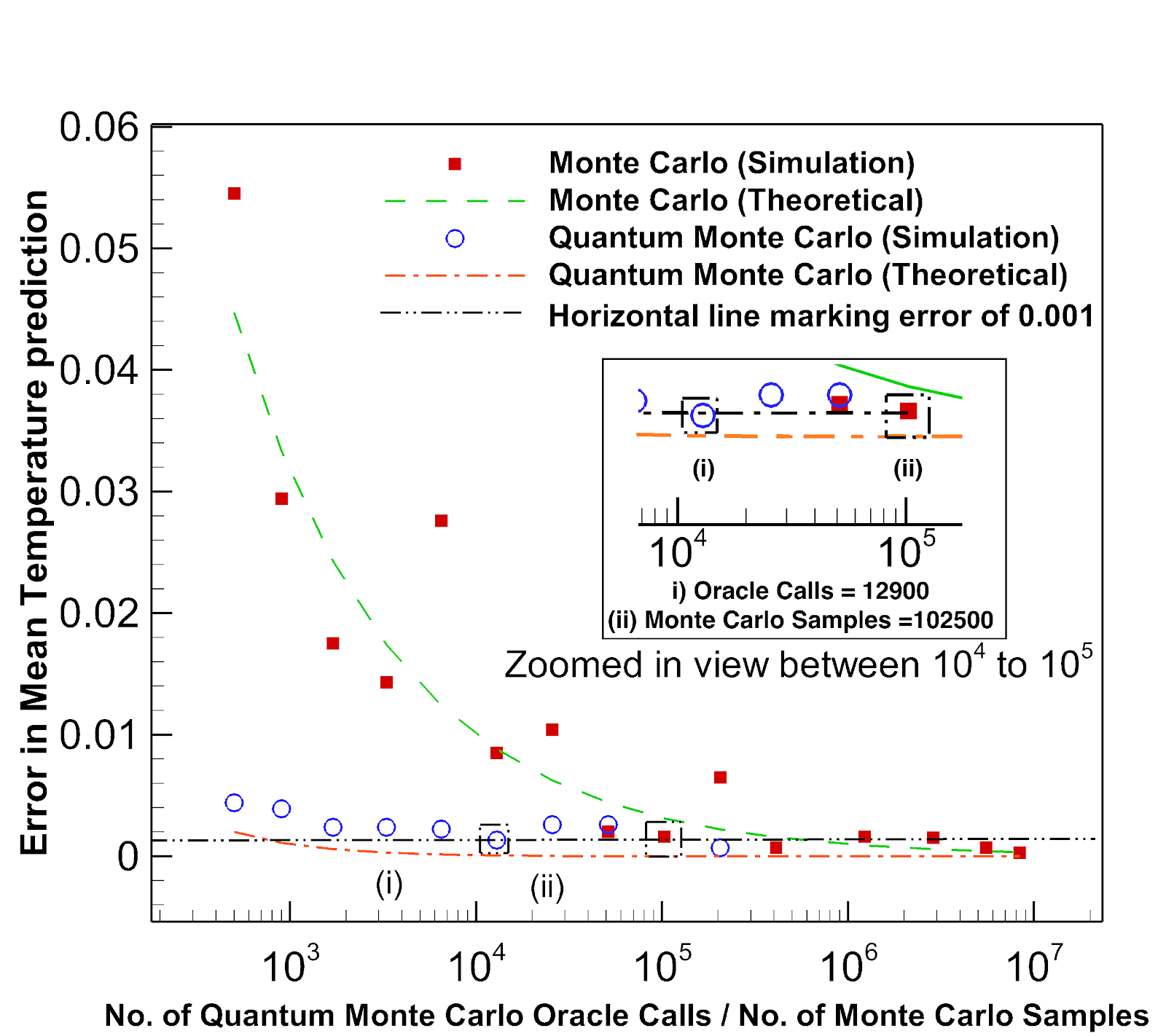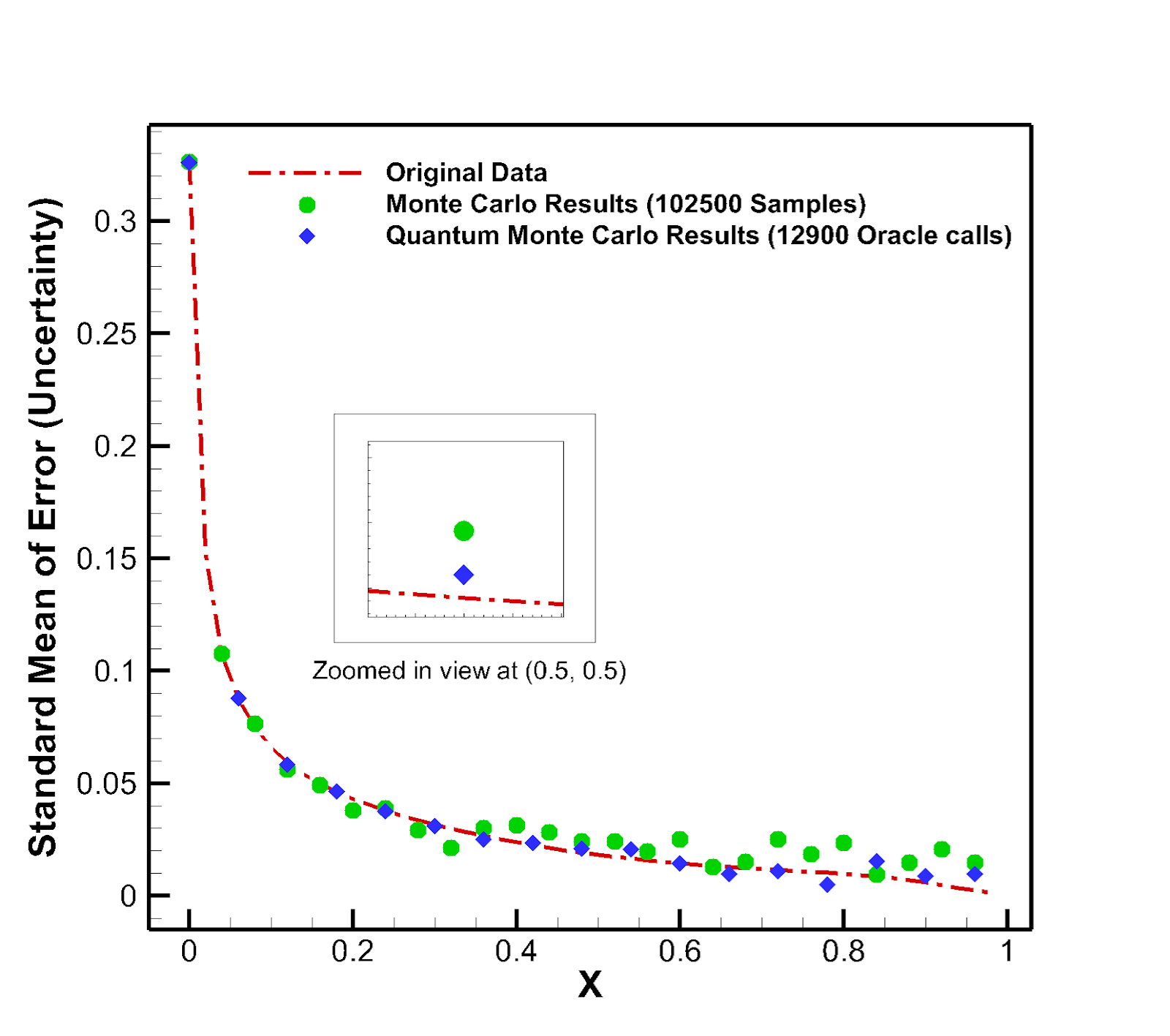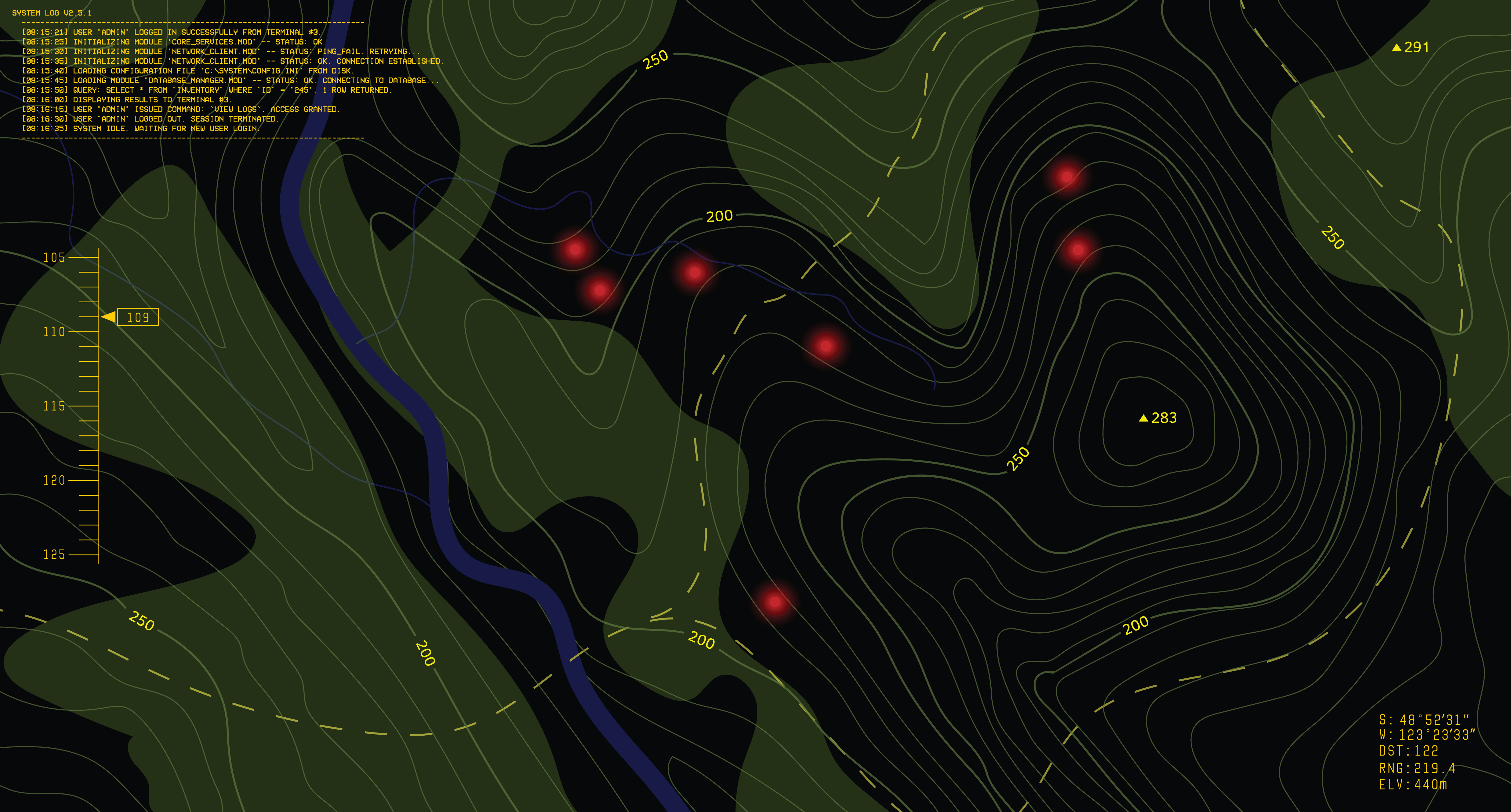Efficient and robust uncertainty quantification (UQ) is essential in aerospace systems, where astrodynamics optimization plays a vital role in ensuring stability and mission success..Both NASA’s CFD Vision 2030 and the Certification by Analysis (CbA) 2040 initiatives emphasize the need for reliable computational predictions across the design and operational lifecycle.
However, UQ in high-fidelity computational fluid dynamics (CFD) comes at a steep computational cost. Classical methods, particularly Monte Carlo (MC), require thousands to millions of simulations, each of which may take hours or days to run. This creates a barrier for practical deployment in design or certification.
Quantum computing has been identified in the CFD Vision 2030 study as a disruptive technology to address such challenges, complementing advances seen in complex simulations and hybrid workflows.While not yet widely applied in UQ, recent research demonstrates a Quantum Computing-based Monte Carlo (QCMC) approach implemented using Qiskit simulators. This method, based on Quantum Amplitude Estimation (QAE) tailored for near-term NISQ devices, shows accuracy comparable to classical MC on heat diffusion problems while reducing sample requirements by almost eightfold.
Uncertainty Quantification (UQ) in Aerospace
Aircraft certification increasingly depends on computational modeling to complement or replace physical testing during Test, Evaluation, Verification, and Validation (TEV&V). The rise of Digital Twins (DT) and Model-Based Systems Engineering (MBSE) reinforces this trend, demanding predictive models that are not only accurate but also validated under uncertainty.
Traditional deterministic CFD simulations yielding a single solution for a fixed input cannot capture the inherent variability in real-world systems. Material properties, boundary conditions, and environmental factors all introduce uncertainty. Designs that ignore variability risk either over-conservatism or unsafe margins.
Two main types of uncertainty matter in this context:
- Aleatoric Uncertainty: Irreducible randomness such as manufacturing tolerances or environmental fluctuations.
- Epistemic Uncertainty: Lack of knowledge from modeling assumptions, boundary condition choices, or incomplete physics, which can be reduced with better models or data.
UQ provides a systematic way to account for these factors, ensuring that certification and design decisions remain robust.
Limitations of Traditional UQ
Classical Monte Carlo methods, while simple and non-intrusive, converge slowly. Estimating the expectation of a quantity of interest with error tolerance ϵ requires on the order of O(1/ϵ2) samples. For high-fidelity CFD, this is infeasible.
Even reduced-order models, while faster, may introduce errors or lose critical details in turbulent or nonlinear flow regimes. Thus, UQ remains a major computational bottleneck in aerospace CFD.
Why BQP’s Quantum Monte Carlo (QMC) is Promising
Quantum Monte Carlo addresses this bottleneck through Quantum Amplitude Estimation (QAE), which achieves a quadratic improvement in sampling complexity. Specifically, the number of required samples reduces from O(1/ϵ2) in Monte Carlo to O(1/ϵ) in QMC.
This reduction means that high-fidelity CFD UQ studies could become computationally viable without compromising accuracy advancing ongoing efforts in quantum algorithms for aerospace and defense.Moreover, quantum algorithms are naturally suited for probabilistic tasks like UQ, making them an attractive fit. To fully realize these benefits, BQP’s research into scalable QMC implementations has advanced in parallel with maturing quantum hardware.
Problem and Challenge Addressed by BQP
Aerospace UQ often involves high-dimensional integrals over uncertain input spaces. Analytic solutions are rarely possible, and MC sampling becomes the default tool—albeit with high cost.
The QCMC algorithm aims to retain the rigor of MC while reducing cost similar to approaches used in design optimization for high-performance aerospace structures.. Yet challenges remain:
- Resource constraints: Direct application of QMC to large CFD problems may require excessive qubits or circuit depths.
- Algorithmic adaptation: Standard QAE requires quantum phase estimation, impractical for NISQ-era devices.
BQP’s QMC has explored a Fourier-based function decomposition strategy combined with QAE without phase estimation (Suzuki’s formulation). The method encodes uncertain inputs efficiently into parameterized rotations, enabling practical application to thermal and aerodynamic problems.
Results
The QCMC framework was validated on thermal conduction problems with uncertain conductivity and boundary conditions. Temperature fields were generated for each realization, and results compared against classical MC.
Sample Complexity:
Classical MC requires O(1/ϵ2) samples. For an accuracy of 10−3, this amounted to ~102,500 samples. QCMC achieved the same tolerance with only ~12,900 oracle calls—an order of magnitude reduction.
Convergence Rate:

Fig: Comparison of Monte Carlo and Quantum Computing Monte Carlo prediction for the 1𝑠𝑡 statistical moment at the domain center
QCMC showed faster convergence for smaller sample sizes. At larger sample counts (~105 realizations), the advantage diminished, with performance approaching classical MC.
Error Bounds and Confidence Intervals:

Fig: Comparison of predictions for standard error of mean
Predictions from QCMC matched classical MC within 90% confidence intervals across the domain. Higher uncertainty was observed near perturbed boundaries, while diffusive effects dampened variability further into the domain. Both methods captured these trends consistently.
Algorithmic Limitations:
While QCMC outperformed MC, results fell short of theoretical predictions due to reliance on classical optimization steps and absence of fault-tolerant quantum hardware. This highlights the need for further refinements in near-term implementations.
Why It Is Significant
BQP’s findings demonstrate that Quantum Monte Carlo can reduce the cost of uncertainty quantification in CFD without loss of accuracy. The implications for aerospace and defense include:
- Design and Certification: Enables probabilistic risk assessment and uncertainty-aware certification without prohibitive computational expense.
- Digital Twins: Integrates UQ directly into real-time simulation and monitoring frameworks for aircraft and spacecraft.
- Scalable Adoption: Provides a clear, incremental path for adopting quantum computing in engineering workflows as hardware matures.
- Operational Reliability: Supports robust performance predictions across uncertain environments, directly impacting safety and efficiency.
While challenges remain, the work shows that QMC is not only theoretically appealing but also practically implementable in the NISQ era.
Uncertainty quantification is central to aerospace system design and certification, yet current methods remain computationally burdensome. Quantum Monte Carlo offers a scalable and efficient alternative. QCMC can achieve the same statistical confidence as classical Monte Carlo with significantly fewer realizations.
As quantum technologies mature, integrating QMC into CFD pipelines is a critical step toward building reliable, uncertainty-aware digital twins and advancing Certification by Analysis in aerospace engineering.
If you’re ready to simplify your local SEO strategy, Booktara makes it effortless. With automated review collection, GBP sync, and performance analytics, you get more visibility with less effort.
Book a Free Demo with Booktara and see how automation can fuel your growth.
FAQs
What is Uncertainty Quantification (UQ) in aerospace?
Uncertainty Quantification (UQ) assesses how variability in inputs—such as material properties, boundary conditions, or environmental factors—impacts the reliability of aerospace system predictions.
Why is classical Monte Carlo (MC) inefficient for aerospace CFD?
Classical MC requires thousands to millions of high-fidelity simulations, each demanding hours or days of compute time. This makes it computationally infeasible for large-scale CFD problems.
How does Quantum Monte Carlo (QMC) improve efficiency?
QMC leverages Quantum Amplitude Estimation (QAE) to reduce sample requirements from O(1/ϵ²) in classical MC to O(1/ϵ). This quadratic speedup means far fewer simulations are needed for the same accuracy.
What were the results of BQP’s Quantum Monte Carlo experiments?
BQP’s QCMC framework reduced required samples by nearly 8× compared to classical MC, achieved accurate results within 90% confidence intervals, and validated thermal conduction problems with uncertain boundary conditions.
What are the practical applications of QMC in aerospace?
QMC supports digital twins, certification by analysis, risk assessment, and robust performance prediction across uncertain conditions—benefiting aircraft design, spacecraft operations, and defense systems.





.png)
.png)




.svg)
.svg)
.svg)
.svg)